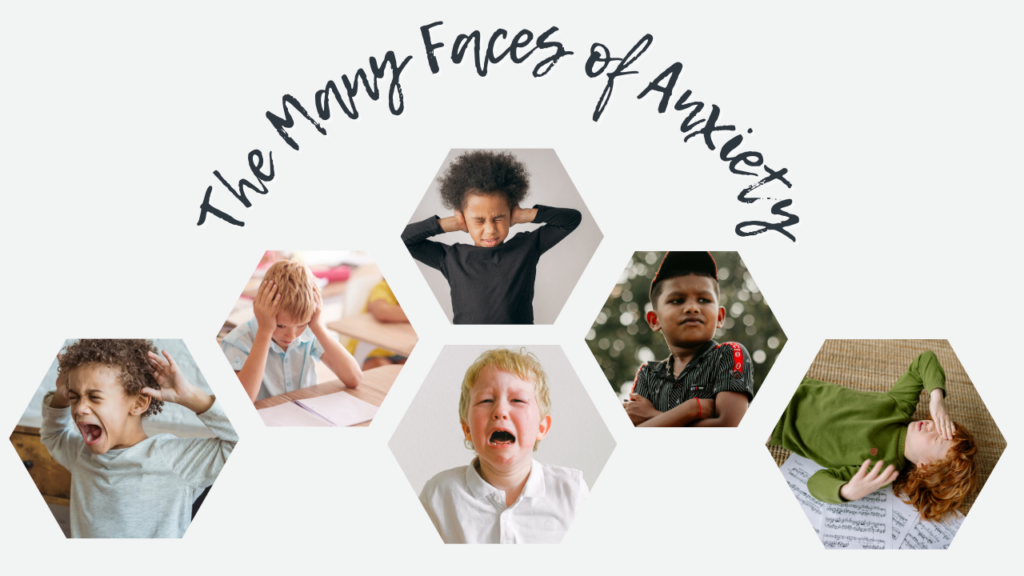Do you remember the first time you encountered anxiety? Perhaps it was a fluttering in your stomach before a big test or a sudden rush of unease in a new situation. Anxiety can be a complex and elusive emotion, especially for children. In my work with elementary students, I’ve seen how anxiety can manifest in various ways, often hidden beneath the surface. Let’s explore the many faces of anxiety. And let’s learn about Scout and Einstein, two Cranium Critters, who can help children manage those big emotions.
The Many Faces of Anxiety
Anxiety is like a chameleon; it can disguise itself in different forms, making it challenging to identify, especially in young minds. Here are a few faces anxiety might wear:
- The Non-Starter: Imagine a student who becomes a perfectionist when faced with schoolwork. They get stuck before they even begin, can’t seem to move forward, and often resist asking for help. This isn’t procrastination or stubbornness; it’s anxiety. The perfectionist fears making mistakes or falling short of expectations, making it hard to seek assistance.
- The Silence Seeker: Some children instinctively seeks solace from overwhelming sensory stimuli. They automatically cover their ears and shut their eyes tight. At first glance, this response might seem like stubbornness or opposition, but it may actually be a quiet plea for respite from the sensory storms that anxiety can bring.
- The Dramatic Reactor: A child may dramatically flop to the ground in response to what may seem like a small concern. But it sure feels like a BIG concern to them! At first glance, this behavior might appear overdramatic, but it’s actually an expression of the intense emotions that can accompany anxiety. It’s a reminder that anxiety is often disguised behind unexpected reactions.
- The Screaming Meanie: The Screaming Meanie is like a storm cloud of anger that erupts when anxiety boils over. Children experiencing this face of anxiety may display intense bursts of anger that hide underlying worries and fears.
- The Tearful Troubadour: It’s not unusual for a child’s anxiety to spill over in the form of tears and emotional outbursts. What may appear to be triggered by a seemingly small issue can quickly become a flood of tears, leaving both children and adults perplexed.
- The Overthinker: Do you know a child who grapples with anxiety by overanalyzing scenarios and conversations in their mind? Meticulously dissecting every detail and imagining the worst possible outcome is a common symptom of anxiety in children.
Tips for Parents and Educators
Here are some specific tips for parents and educators on how to help children manage their anxiety:
- Identify anxiety triggers. The first step to helping a child manage their anxiety is to identify their triggers. This can be done by observing the child’s behavior and paying attention to the situations that seem to make them anxious. Once you know what the child’s triggers are, you can start to develop strategies for helping them cope.
- Teach coping mechanisms. There are a number of coping mechanisms that can help children manage their anxiety. Some common coping mechanisms include deep breathing, relaxation techniques, and positive self-talk. You can teach your child these coping mechanisms by practicing them together and providing them with support when they are feeling anxious.
- Create a supportive environment. Children need to feel safe and supported in order to manage their anxiety. This means creating a home and school environment where they feel comfortable talking about their feelings and seeking help when they need it. You can also model healthy coping mechanisms for your child by showing them how you manage your own anxiety.
Introducing Scout and Einstein
Scout and Einstein are two lovable characters from our “Cranium Critters” picture book series. They are here to guide children through the maze of emotions, especially when anxiety takes hold.
- Scout, the Brain’s Safety Pup: Scout is like the brain’s alarm system. She’s always on the lookout for potential danger and sends out alerts when she senses something is amiss. With Scout’s help, children can learn to recognize their anxiety triggers and understand the brain’s fight, flight, and freeze response.
- Einstein, the Brain’s Head Thinker: Einstein is the mastermind behind decision-making and problem-solving. When children face challenges or distractions, Einstein can help them focus, plan, and manage those tricky situations.

How Cranium Critters Books Can Help
Cranium Critters books can play a valuable role in helping children to understand and manage their anxiety in a number of ways:
- They provide information on brain awareness for parents and teachers. This information can help adults to better understand what is happening in a child’s brain when they are feeling anxious. This can make them more effective in helping the child to cope.
- They include a number of breathing exercises and calming techniques to help children regulate their emotions. These exercises and techniques can be taught to children while they are feeling calm, and used by them when they are feeling anxious.
- They teach children how to use a Pause Place. The Pause Place is a space set aside for taking a break when we are feeling overwhelmed. The book can help children to understand the importance of the Pause Place and how to use it when they need to.
Little Life Lessons • BIG Life Skills
Anxiety is a complex emotion that can manifest in various ways, often hidden from plain sight. By helping children to understand and manage their anxiety, we can teach them valuable life skills that will benefit them throughout their lives.
Here are a few of the big life skills that children can learn by managing their anxiety:
- Self-awareness: Learning to identify their anxiety triggers and understand their body’s response to anxiety can help children to become more self-aware. This self-awareness can be applied to other areas of their lives, such as their relationships, their academics, and their overall well-being.
- Coping skills: When children learn how to cope with their anxiety in a healthy way, they are developing coping skills that can be used to manage other challenges in their lives. These coping skills can include things like deep breathing, relaxation techniques, and positive self-talk.
- Resilience: When children learn to overcome their anxiety, they are developing resilience. Resilience is the ability to bounce back from setbacks and challenges. It is a valuable life skill that can help children to succeed in all areas of their lives.
The Cranium Critters books and lessons can help children to develop these big life skills by providing them with information, tools, and strategies for understanding and managing anxiety. By helping children to manage their anxiety and other uncomfortable emotions, we can help them to develop the skills they need to live happy and successful lives.

